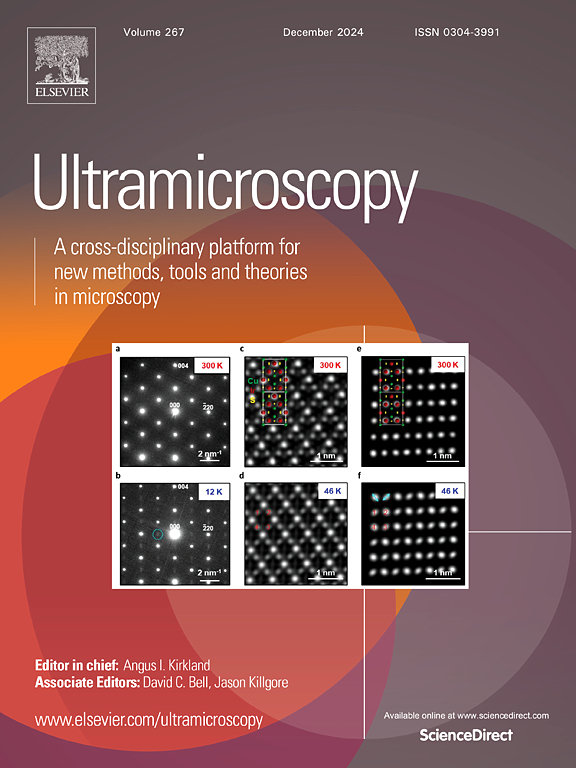厚样品高分辨率成像中MeV电子束能量依赖角展宽的实验研究
IF 2
3区 工程技术
Q2 MICROSCOPY
引用次数: 0
摘要
在扫描透射电子显微镜(STEM)中,空间分辨率主要受样品内电子探针投影尺寸的影响。在薄样品中,大的半会聚角使光束紧密聚焦和亚纳米分辨率成为可能。然而,在厚样品中,分辨率基本上受到多个大角度散射事件引起的横向光束展宽的限制——例如,一个10 μm角发散的探针可以在10 μm路径上展宽约100 nm。由于这种增宽与光束能量成反比,MeV-STEM为厚材料的高分辨率成像提供了一条很有前途的途径。为了定量评估这种影响,我们在加州大学洛杉矶分校的PEGASUS光束线上进行了高精度测量,表征了3-8 MeV电子通过不同厚度的楔形硅样品传输的光束发散和强度分布。我们的结果调和了分析模型之间的差异,并验证了蒙特卡罗模拟。我们发现,将束流能量从3.0 MeV增加到5.8 MeV,会使角展宽降低2.6倍,而在7.6 MeV时,会观察到收益递减。这些发现为优化MeV-STEM在厚生物和微电子标本高分辨率成像中的参数提供了定量框架,并为STEM以外的其他高级成像模式中的光束能量选择提供了指导。本文章由计算机程序翻译,如有差异,请以英文原文为准。
Experimental study of energy-dependent angular broadening of MeV electron beams for high-resolution imaging in thick samples
In scanning transmission electron microscopy (STEM), spatial resolution is primarily influenced by the projected size of the electron probe within the specimen. In thin samples, a large semi-convergence angle enables a tightly focused beam and sub-nanometer resolution. However, in thick specimens, resolution is fundamentally limited by transverse beam broadening from multiple large-angle scattering events—for example, a probe with 10 mrad angular divergence can broaden by ∼100 nm over a 10 μm path. Since this broadening scales inversely with beam energy, MeV-STEM offers a promising route for high-resolution imaging in thick materials. To quantitatively assess this effect, we performed high-precision measurements at UCLA’s PEGASUS beamline, characterizing beam divergence and intensity profiles for 3–8 MeV electrons transmitted through a wedged-silicon sample of varying thickness. Our results reconcile discrepancies among analytical models and validate Monte Carlo simulations. We find that increasing beam energy from 3.0 to 5.8 MeV reduces angular broadening by a factor of 2.6, with diminishing returns observed at 7.6 MeV. These findings provide a quantitative framework for optimizing MeV-STEM parameters in high-resolution imaging of thick biological and microelectronic specimens, and for guiding beam energy selection in other advanced imaging modes beyond STEM.
求助全文
通过发布文献求助,成功后即可免费获取论文全文。
去求助
来源期刊

Ultramicroscopy
工程技术-显微镜技术
CiteScore
4.60
自引率
13.60%
发文量
117
审稿时长
5.3 months
期刊介绍:
Ultramicroscopy is an established journal that provides a forum for the publication of original research papers, invited reviews and rapid communications. The scope of Ultramicroscopy is to describe advances in instrumentation, methods and theory related to all modes of microscopical imaging, diffraction and spectroscopy in the life and physical sciences.
 求助内容:
求助内容: 应助结果提醒方式:
应助结果提醒方式:


